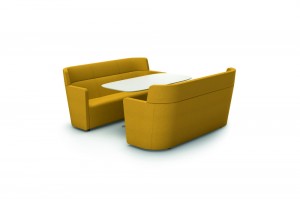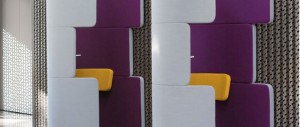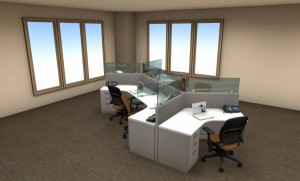
Diner-style booths are one way companies have found to offer employees a private place for conversations. Photo courtesy of Bene.
It looks like for better or for worse, those nice high cubicle walls won’t be coming back anytime soon because employers are just too in love with open plan office spaces. Of course, any new-fangled idea has its benefits and drawbacks, and the trend of tearing down office walls is no exception. We outlined a few of the biggest pros and cons to open work spaces and offered ideas for how to ease the transition in your office.
Pros
More communication: One of the main reasons businesses cite for going with an open plan office is to increase the communication and collaboration among employees. By lowering the walls or getting rid of them altogether, organizations can facilitate quick, frequent exchanges of information and ideas which hopefully in turn can lead to increased productivity and creativity. In addition, many employees appreciate the greater sense of community and inclusiveness that results when employees are in the know while on the job.
Less expensive: One major benefit of open plan workspaces to employers is that they can help reduce costs. More people can work in less space which means companies don’t need to lease as much square footage, offering savings on real estate. Plus, compared with traditional high-walled cubicles, workstation solutions like benching or smaller, low-walled cubicles cost less.
More natural light: Tearing down walls allows everyone in the office a chance to enjoy what is arguably our greatest natural resource: The sun. Giving your entire office access to natural light (instead of just the lucky few with offices on the periphery of the building) will save money on energy bills by not having to rely as much on electric lights, reduce your carbon footprint, and reduce eye strain among employees. Studies have found that natural light helps improve people’s attitudes, which translates into increased productivity and camaraderie on the job.
Cons
More noise: By far one of the biggest complaints about open offices is the level of noise, especially talking. “Noise is the most serious problem in the open-plan office, and speech is the most disturbing type of sound because it is directly understood in the brain’s working memory,” Valtteri Hongisto, an acoustician at Finland’s Institution of Occupational Health, told the New York Times in 2012. The institute found a decline of 5 to 10 percent in cognitive tasks requiring short-term memory (things like reading, writing and other creative work) when the person is an unwilling listener to other conversations.
Less status: In 2007, Knoll conducted a study on how the physical work environment affects employee attitudes, expectations and satisfaction. More than half of the study participants acknowledged that the size and quality of their workspace is a reflection of their status within the company. Even though companies have tried to change this perception over the years, when someone who’s been working from a giant corner office suddenly finds themselves working without walls next to the rest of their colleagues, egos can be bruised.
Less privacy: Nine out of 10 respondents to Knoll’s survey said privacy was the number one advantage of a closed space work environment. Walls help employees feel more secure and protected from prying eyes and ears. They are ideal for employees who need to complete more focused work, or those who need to have sensitive conversations (i.e.: managers disciplining employees, human resources representatives, private meetings with clients, etc.). When the walls come down, privacy goes away which could make employees feel uneasy.
How to Ease the Transition
Of course, employees don’t always like change, especially change that will potentially mean less workspace, privacy and more noise. To help ensure buy-in with your new office layout, start by looking for ways to soundproof the room so that employees aren’t distracted by conversations happening across the room from them. Some offices have found success using systems that pump in a neutral background noise that helps reduce the sound of talking far away or by adding soundproofing to cubicles.
Thoughtful design will also help. Include a mix of private meeting rooms and less formal meeting spaces and alcoves throughout the office where two or more people can have a spur-of-the-moment chat. Some companies have found it helpful to include phone booths where employees can go to have a private conversation. Talk to different departments within your company to learn more about how your employees work and plan to seat them according to how much “heads-down” time they need (like programmers) versus those who do more teamwork-oriented tasks.

These uber-modern phone booths by furniture designer Bene are one solution for giving employees in an open office a place to retreat for a private conversation. Photo courtesy of Bene.
According to the New York Times, booths like those you would find in a restaurant have become popular with office designers because they offer a more private retreat for a conversation, while still being able to monitor what’s happening around you. Furniture designer Bene offers a sophisticated take: a pair of high-backed wingback chairs that each seat two to three people with headrests and a small table offering a spot for a private meeting in the middle of all the action.

Workstations like these high-tech modular pods available at Arnolds give employees a little extra privacy while still maintaining an open office.
While the goal is to take down walls, you can help increase your employees feelings of privacy by using glass-topped partitions on workstations. Employees will still be able to engage with one another without having to listen to every little sound their neighbors make.





